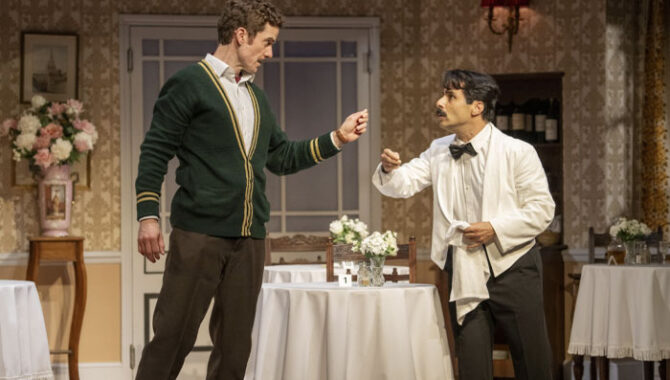—-
To stay in the loop with the latest features, news and interviews from the creative community around licensing, sign up to our weekly newsletter here

Aardman’s Molly Van Den Brink, Start Licensing’s Ian Downes and Rainbow Productions’ Simon Foulkes discuss brands treading the boards.
 Molly Van Den Brink, Attractions & Live Experiences Manager, Aardman
Molly Van Den Brink, Attractions & Live Experiences Manager, Aardman
From the perspective of someone working in the LBE industry – as well as a parent of two children under the age of six – I am always fascinated to see not only which brands launch their characters onto the stage (and achieve success in this space), but also the mechanics they use to achieve this creatively.
The core challenge in moving well-loved characters from screen or book to stage is taking them away from their own worlds, recreating them in physical form and bringing them into ours… All without losing the authenticity, integrity and creativity which likely made them popular enough with audiences in the first place to enable this ancillary exploitation.
Character costumes have a beloved place in children’s hearts, due to the tactile nature of being able to interact with their favourite characters ‘for real life’ – to use a certain Blue Heeler’s catchphrase! However, many brands have been pivoting away from this when recreating their characters on stage, breathing life and authenticity by using a variety of puppets, costumes, digital and immersive techniques.

Since the pandemic suffocated the arts beyond recognition, now that consumer confidence has begun – or is beginning – to be on the up, there seems a trend towards audiences being hungry to watch their favourite brands and characters on stage. It offers a truly immersive experience, enabling fans to engage with storylines and characters on a deeper and more personal level.
The brands which seem to fare well in this space tend to be those which not only leave fans desperate for more – more detail, more action, more storylines – but also those which have ultimately created worlds and characters which can be enjoyed multiple times, across multiple generations, all engaged at different levels and for different reasons. Disney have achieved this for 27 years and counting with my firm favourite, The Lion King, in ways other brands can only dream of. It suggests that true success on the stage means fans struggling to choose whether they would prefer to watch the screen or the stage show.
While an extremely competitive sector, there is certainly space in the market for the right brands to create timeless, globally recognised stage adaptations as well as the smaller scale, quirky and unique touring adaptations which we are seeing across examples like the Julia Donaldson portfolio.
Based on the current, global phenomenon, combined with the creative and narrative flex possibilities, I would hedge a bet on Barbie gracing the stage in some shape or plastic form soon successfully – which would certainly delight my daughter!

 Ian Downes, Director, Start Licensing
Ian Downes, Director, Start Licensing
One of the challenges that production companies and rights owners face is ensuring that there is an audience that will want to pay to see a stage adaptation. Many good ideas have fallen foul of poor ticket sales. As I understand it, the Fawlty Towers stage show has had a good uptake and ticket sales have been strong. This should encourage creators and owners to think about the potential for taking TV comedy from screen to stage.
I expect to see more ideas explored from this genre over coming months. Indeed, the musical version of Only Fool and Horses seems to have been a big success. In this regard there is a good commercial argument for producers to reference in terms of TV comedy working on stage.
TV formats have inspired a lot of successful stage adaptations – a great example is Brainiac. This TV show – originally screened on Sky – has been running on stage for a number of years. One key to its success seems to be that it’s a well-defined brand both stylistically and content-wise.

It filled a gap and was developed in an imaginative but ‘on brand’ way. It’s also a production that has been developed across a range of venues – from sites like Butlin’s to festivals through to the West End. It’s s creatively flexible and the teams involved have recognised that flexibility is a commercial strength. In simple terms, it opens up more selling opportunities.
The rise of more specialist TV channels like Discovery and Quest should help with stage adaptations… These channels are subject focused, are good at building brands and attract loyal audiences. Shows like Salvage Hunters could work in an ‘Evening With’ type formats, but there is scope to adapt these sorts of shows further majoring on the ‘challenge’ aspect of them. Brainiac is a great example of how the stage show has built on the TV theme but also adapted things to suit the live format.
I would also suggest All Creatures Great and Small could work well on stage – although there might need to be a lot of action ‘off stage’… I am not sure the West End is ready to host a herd of cows!

 Simon Foulkes, MD, Rainbow Productions
Simon Foulkes, MD, Rainbow Productions
All brands are ripe for stage adaption. Live engagement is a key part of a brand’s evolution, with linear and on demand broadcasting being so diluted, stage productions are an avenue IPs are finding integral to creating emotional attachments. But aren’t traditional stage shows archaic?
We are seeing all forms of stage productions being adopted by IPs, whether it is Studio Ghibili’s characters portrayed as puppets in the stage shows of My Neighbour Totoro and Spirited Away, or Doc Brown and Marty McFly singing their way through Back to the Future: The Musical… Or even Olaf and Elsa ice skating their way through a performance of Frozen on Ice.

Traditional forms of theatre and stage production like the above are given a modern twist with the incredible advancements in AR and VR, showing the only thing stopping any IP maximising its stage presence is imagination. Boundaries are being pushed by these cutting-edge technologies which allow digital characters or landscapes to seamlessly interact with live actors and audiences, making for a truly extraordinary theatrical experience.
Clearly younger target markets featuring Bluey is Rainbow Productions’ area of expertise, as we manage the personal appearances of over 140 licensed children’s characters at events. We are the opposite end of the spectrum to Stranger Things and Fawlty Towers, whose target market ranges from young adult to seniors. That being said, brands that skew slightly older and do not necessarily have mainstream broadcast exposure can still succeed in the live space.
The huge success of AR and VR live experiences – such as Monopoly Lifesized, Van Gogh: The Immersive Experience and ABBA Voyage – open up opportunities for the like-willed and have massive appeal to family audiences. Imagine Game of Thrones with dragons soaring above spectators, Minecraft with ever-changing sets or going on a wild adventure with Pippi Longstocking… The possibilities are endless.
Stage shows are fast becoming another piece in a brand’s portfolio. As I look at non-mainstream entertainment brands, the opportunities for their target markets and new territories to experience immersive non-proscenium arch productions are vast. Creativity is intrinsic to licensing and therefore a better question would be: ‘What other brands are not ripe for a stage adaptation?’
Enter your details to receive Brands Untapped updates & news.